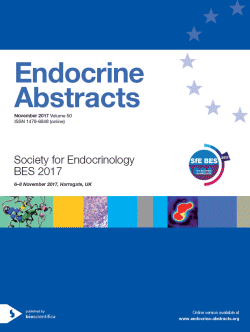
Society for Endocrinology BES 2017
Harrogate,
UK
06 Nov 2017 - 08 Nov 2017

Poster Presentations
Reproduction
ea0050p351 | Reproduction | SFEBES2017
Mass spectrometry-based assessment of androgen excess in 1205 consecutive patients over 5 years: PCOS most common diagnosis, but severe androgen excess indicates other ovarian and adrenal pathology
Elhassan Yasir , Idkowiak Jan , Smith Karen , Asia Miriam , Webster Rachel , Arlt Wiebke , O'Reilly Michael
ea0050p352 | Reproduction | SFEBES2017
A comparison of Ovarian Hyperstimulation Syndrome (OHSS) parameters following different triggers of oocyte maturation during IVF Treatment
Clarke SA , Abbara A , Islam R , Jeffers L , Christopoulos G , Comninos AN , Salim R , Lavery SA , Trew GH , Dhillo WS
ea0050p353 | Reproduction | SFEBES2017
Polycystic ovary syndrome is associated with adverse mental health and neurodevelopmental outcomes: a retrospective, observational study
Berni Thomas , Morgan Christopher , Berni Ellen , Rees Aled
ea0050p354 | Reproduction | SFEBES2017
Metformin improves oestrous cycle, ova count and expression of oestrogen receptors in diabetic female Sprague-Dawley rats.
Ojulari Lekan , Morakinyo Femi , Kadir E , Abdulazeez F , Adegoke Olufeyi
ea0050p355 | Reproduction | SFEBES2017
RNA-Sequencing reveals a downregulation of cholesterol metabolism pathways in granulosa cells from women with PCOS
Lerner A , Caraderi T , Drong A , Makrinou E , Christopoulos G , Liyanage M , Lavery S , Hardy K , Lindgren C , Franks S
ea0050p356 | Reproduction | SFEBES2017
Impact of delayed pubertal induction and route of estrogen administration on health parameters in adults with Turner Syndrome
Cameron-Pimblett Antoinette , Davies Melanie , Conway Gerard
ea0050p357 | Reproduction | SFEBES2017
Metabolic syndrome reduce gravid uterine contractility in female sprague-dawley rat
Iranloye Bolanle , Adoga Jeffery , Adejare Abdullahi , Faniru Yewande
ea0050p358 | Reproduction | SFEBES2017
Pregnancy, pre-eclampsia and vitamin D: a multi-scale mathematical approach
Beentjes Casper , Tamblyn Jennifer , Bayani Anahita , Davis Christopher , Dunster Joe , Mirams Gary , Taylor-King Jake , Jabbari Sara , Kilby Mark , Hewison Martin
ea0050p359 | Reproduction | SFEBES2017
Is serial urinary progesterone measured via automated chemiluminescent assay a valid alternative to pregnanediol via manual ELISA for the detection of ovulation?
Gifford Robert , Reynolds Rebecca , Anderson Richard , Woods David
ea0050p360 | Reproduction | SFEBES2017
Aberrant fetal development precipitated by genistein is accompanied with disruption in the Giant Trophoblast cell histomorphometry, and alteration in the serum, placenta and the amniotic fluid oxidation-reduction system
Awobajo Funmileyi , Morakinyo Ayodele , Samuel Titilola , Oyelowo Oluwakemi , Onyekwele Perpetual , Okedina Mosunmola
ea0050p361 | Reproduction | SFEBES2017
Non-cardiac maternal and fetal outcomes in Turner Syndrome pregnancies.
Spain Geraldine , MacKillop Lucy , Turner Helen
ea0050p362 | Reproduction | SFEBES2017
Kisspeptin-leptin interplay in assisted reproductive techniques
Rehman Dr Rehana , Jamil Dr Zehra , Fatima Syeda Sadia , Khalid Aqsa , Mumtaz Aaida
ea0050p363 | Reproduction | SFEBES2017
Effects of myoinositol and D-chiro inositol on hyperandrogenism and ovulation in women with polycystic ovary syndrome: a systematic review
Amoah-Arko Afua , Evans Meirion , Rees Aled
ea0050p364 | Reproduction | SFEBES2017
Aortic dissection in Turner syndrome: a single centre experience
Calanchini Matilde , Myerson Saul , Turner Helen , Orchard Liz
ea0050p365 | Reproduction | SFEBES2017
Effects of feed supplementation with olive oil on serum testosterone, triiodothyronine, thyroxine and some biochemical metabolites in Teddy goat bucks
Farooq Muhammad , Ali Shujait , Jamil Huma , Ahmad Nazir , Ashfaq Khurram
ea0050p366 | Reproduction | SFEBES2017
Audit of endocrine investigations undertaken in females with elevated testosterone
Frank Amy R , Jeffery Jinny , Pinkney Jon , Costelloe Sean J
ea0050p367 | Reproduction | SFEBES2017
Turner syndrome management. Are we going along with the new clinical guidelines?
Kakouri Eleni , Michala Lina , Ntali Georgia
ea0050p368 | Reproduction | SFEBES2017
Polycystic Ovarian Syndrome (PCOS): Social situation influences Cardiometabolic Outcome
Heald Adrian H , Livingston Mark , Holland David , Moreno Gabriela Y C , Donnahey Gemma , Duff Christopher J , Shalet Shashana , Wu Pensee , Fryer Anthony A
ea0050p369 | Reproduction | SFEBES2017
Polycystic Ovarian Syndrome: Assessment of approaches to diagnosis and cardiometabolic monitoring in UK primary care
Heald Adrian H , Livingstone Mark , Holland David , Robinson John , Moreno Gabriela Y C , Donnahey Gemma , Duff Christopher J , Wu Pensee , Fryer Anthony A
ea0050p370 | Reproduction | SFEBES2017
High prevalence of multimorbidity in overweight and obese women with Polycystic Ovary Syndrome (PCOS)
Mani Hamidreza , Chudasama Yogini , Bodicoat Danielle , Levy Miles , Gray Laura , Howlett Trevor , Khunti Kamlesh , Davies Melanie
ea0050p371 | Reproduction | SFEBES2017
Standardisation of care: a quality improvement project in Polycystic Ovary Syndrome (PCOS) clinic
Mani Hamidreza , Bhake Ragini , Levy Miles , Reddy Narendra
ea0050p372 | Reproduction | SFEBES2017
A rare case of Gestational Hyperandrogenism
ea0050p373 | Reproduction | SFEBES2017
Successful stimulation of spermatogenesis in a man with hypogonadotrophic hypogonadism, azoospermia, previous right orchidectomy and a remaining small left testicle
ea0050p374 | Reproduction | SFEBES2017



